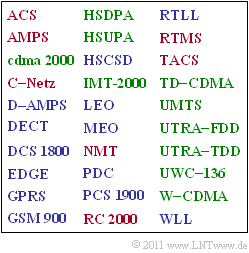Difference between revisions of "Aufgaben:Exercise 3.1: Development of the Mobile Network"
m (Text replacement - "Mobile Kommunikation/Historie und Entwicklung der Mobilfunksysteme" to "Mobile_Communications/History_and_Development_of_Mobile_Communication_Systems") |
|||
| Line 1: | Line 1: | ||
| − | {{quiz-Header|Buchseite= | + | {{quiz-Header|Buchseite=Mobile_Communications/History_and_Development_of_Mobile_Communication_Systems |
}} | }} | ||
Revision as of 15:01, 15 December 2020
The first mobile communication systems came onto the market in the mid to late 1950s, in Germany for example the so-called A-network.
However, the devices of that time cannot be compared with today's mobile phones in any way, either in terms of performance, volume or even more so in terms of weight.
Since the early 1980s, the development of mobile communications technology has progressed rapidly. Approximately every ten years, there have been significant changes in technology, performance and the services offered.
The fourth generation $\Rightarrow$ $\Rightarrow$ Long Term Evolution (LTE) was specified in 2008 with UMTS Release 8 and has also been available in Germany since around 2013, although it is not yet available nationwide today (2017).
Notes:
- The task belongs to the chapter Historie und Entwicklung der Mobilfunksysteme.
- In the diagram some terms and abbreviations of mobile radio are shown. There is no direct reference to the task.
- The colors indicate that the systems belong to the first, second and third generation of mobile radio.
Questions
Solutions
(1) Correct are the solution suggestions 1 and 4:
- Die erste Generation der Mobilkommunikation (1G) bietet nur analoge Sprachübertragung.
- Zusätzlich zu den oben genannten Systemen sind auch ACS, NMT, TACS, RTMS und RC 2000 in der ersten Mobilfunkgeneration
(in der Grafik auf der Datenseite rot markiert) enthalten. - Sie alle kamen Anfang bis Mitte der 1980er Jahre auf den Markt.
(2) Correct are the solution proposals 1 to 4:
- The best known 2G–representative is GSM, but also the cordless telephony–standard DECT and the Japanese PDC belong to the 2G–systems
(marked blue in the graphic on the information page). - The last statement is wrong: For example, the German D–network (Telekom TD1, Vodafone D2) operates in the frequency range around 900 MHz.
(3) Correct are the statements 1 to 3:
- Shortly after the introduction of GSM in the early 1990s, it became clear that the GSM–data rate $(9.6 \ \rm kbit/s)$ was not sufficient for more demanding applications.
- The GSM–extensions around the turn of the millennium include HSCSD $($up to $57.6 \ \ \rm kbit/s)$, GPRS $($up to $171 \ \ \rm kbit/s)$ and EDGE $($maximum $384 \ \ \rm kbit/s)$.
- HSDPA and HSUPA, which describe further developments of UMTS with regard to higher data rates in the downlink and uplink, may not be added to GSM–Phase 2+.
- EDGE may actually be a further development of GSM, but it is nevertheless also listed as a 3G mobile communications system. The data rate is up to $384 \ \rm kbit/s$.
- The first statement is also correct. With the "Phase 2+" the Adaptive Multi–Rate Codec was also developed. (AMR) was introduced, resulting in better voice quality.
(4) Correct are the statements 2 and 3:
- OFDM-based LTE (Long Term Evolution) brings further improvements and is also called E–UTRA in the UMTS–standard, but it is considered to be fourth generation.
- All systems of the third mobile radio generation are marked green in the graphic on the information page.
